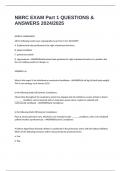NBRC EXAM Part 1 QUESTIONS &
ANSWERS 2024/2025
PATIENT ASSESSMENT:
All the following could cause capnography to go from 3 6 to 30 EXCEPT:
A. Endotracheal tube positioned in the right mainstream bronchus
B. Hyperventilation
C. pulmonary emboli
D. Hypovolemia - ANSWERSEndotracheal tube positioned in right mainstem bronchus is a problem but
the co2 reading would not change, so
ANSWER is A.
What is the target Vt for individual on mechanical ventilation - ANSWERS6-8 ml/kg (of ideal body weight)
This is new strategy as of January 2015
Is the following Static OR Dynamic Compliance:
Means flow throughout the respiratory system has stopped and all ventilatory muscle activity is absent.
_______ conditions can be imposed with an inspiratory pause when a patient is sedated and
mechanically ventilated. - ANSWERSStatic Compliance
Is the following Static OR Dynamic Compliance:
Flow at airway opening is zero. Mechanics are evaluated under ______ conditions, when non-intubated
patient breathes spontaneously. - ANSWERSDynamic Compliance
A balloon tipped flow directed catheter is positioned in the pulmonary artery with the balloon deflated.
Which of the following pressures will be measured by the proximal lumen:
a. Cvp
b. Pap
,c. Pwp
d. Map - ANSWERSANSWER is A. Cvp = deflated/proximal lumen
Pap = deflated/distal
Pwp = inflated/wedged
All of the following will affect the accuracy of a capnography EXCEPT
a. Long sampling line
b. Low sampling flow
c. Condensation in the tubing
d. Use of desiccant - ANSWERSGas will pass through and out of a long sampling line before reaching
analyzer so, low sampling flow will not give you enough information for a good reading, and
condensation as a rule is always a problem especially in analyzers. Dessicant removes moisture from the
gas, which is a good thing, so
ANSWER is D
A 1000 g neonate (normal baby is 3000 g) is stable in nicu. Which of the following should the respiratory
therapist use to monitor the neonates overall cardiopulmonary status.
a. TcPCO2 and TcPO2 monitor
b. Arterial blood gas analysis Q4
c. SpO2 monitor
d. Capillary gas analysis Q8 - ANSWERSSince the baby is stable, go less invasive, also go continuous
monitoring (not 4 hour or 8 hour), Transcutaneous (Tc) continuous monitoring of CO2 and O2 is the best.
Answer is A
A unilateral wheeze would most likely indicate which of the following.
a. Asthma
b. Atelectasis
c. Foreign body aspiration
d. Epiglottitis - ANSWERSYou wouldn't have asthma on just one side (unilateral), atelectasis would cause
diminished breath sounds, with epiglottitis you would get stridor, since you are only hearing wheezing on
one side, you are hearing it on the side where you aspirated something,
,so ANSWER is C
All of the following would be associated with the presence of a pneumothorax EXCEPT
a. Tracheal deviation
b. Dull percussion
c. Absent breath sounds
d. Respiratory distress - ANSWERSWith pneumothorax you would hear a high pitch hyperresonnance,
breath sounds would be absent, and respiratory distress could be present. Dull percussion would NOT be
present,
so ANSWER is B.
What should you recommend FIRST for a patient with multifocal pvc's
a. Administration of lidocaine
b. Administration of 100% oxygen
c. Administration of atropine
d. Administration of epinephrine - ANSWERSMultiple pvc's coming from multiple locations (multifocal) is
a real problem and you should administer oxygen FIRST, so ANSWER is B. lidocaine will help reduce
irritability of heart and help with pvc's but would not be first option, atropine is used for bradycardia and
cardiac irregularities but not pvc's, epinephrine is emergency drug not for pvc's but more for pulseless
ventricular tachycardia or ventricular fibrilation where heart is not responding .
What is the normal range for the mean pulmonary artery pressure in an adult
a. 2-6 mm Hg
b. 4-12 mmHg
c. 9-18 mmHg
d. 21-28 mmHg - ANSWERSMean pulmonary artery pressure in an adult should be in the teens
so best ANSWER is C
, A patient in the emergency dept has frothy secretions, moist crackles, and tachypnea. The patient has
marked dyspnea and a history of heart disease. Which of the following should the respiratory therapist
recommend.
1.suction immediately
2.administer 100% oxygen
3.place in Fowlers position
4.administer furosemide - ANSWERSThis is an emergency, they are having heart problems, dyspnea,
frothy secretions indicating severe pulmonary edema, etc. so 100% oxygen immediately, having the
patient in the Fowlers position (an upright position) will help pull fluid down away from the lungs,
furosemide is a lasix (loop diuretic) which gets rid of excess fluid. You do NOT suction someone with
frothy secretions and heart problems, this just delays appropriate therapy. So ANSWER is 2,3,4
Fine crepitant crackles are most commonly associated with which of the following conditions.
a. Bronchiectasis
b. Congestive heart failure
c. Pneumonia
d. Croup - ANSWERSCrackles are associated with fluid so a, b, and c would be good answers, but "fine
crepitant" crackles indicates fluid entering alveoli (pulmonary edema) which is most often caused by
heart failure so the best ANSWER is B. (with croup you would hear more of a stridor sound).
A patient is found in full cardiopulmonary arrest. CPR is started and the patient is orally intubated with
an EtCO2 monitor attached. Which of the following EtCO2 patterns would the respiratory therapist
expect to observe on the monitor?
a. Initially high, then falling
b. Initially low, then rising
c. Initially high, stays high
d. Initially low, stays low - ANSWERSFull cardiac arrest will cause the CO2 in the lungs to slowly dissipate
out because no blood is flowing, then during CPR when you get blood flowing, the CO2 should slowly
rise back up;
so ANSWER is B
If the blood pressure obtained from the arterial line is higher than the blood pressure obtained from a
sphygmomanometer (cuff pressure). Based upon this information, the respiratory therapist should
conclude that.




